There are two sequence of events that everyone will remember from Game Six of the American League Championship Series.
***
The first is how the Royals regained the lead in the bottom of the eighth. During the top half of the inning, the Royals had blown a two-run advantage by allowing Ryan Madson to pitch to Jose Bautista with Wade Davis warming. While Ned Yost will get the blame for sticking with his third-best reliever, Bautista deserves credit for turning around a mid-90s fastball up and at the top of the strike zone. Who knows; maybe Bautista does the same thing to a Davis offering—he doesn't seem to discriminate.
Anyway, Blue Jays skipper John Gibbons wasn't going to make the same mistake. With the game resuming following a lengthy rain delay, Gibbons sent his brilliant, uncowed 20-year-old closer Roberto Osuna to the mound. Keep the game knotted here, Gibbons probably figured, and we might get our feared two-through-four combination to the plate in the ninth.
Early on, the inning stayed on script. Osuna got ahead 1-2 on leadoff man Lorenzo Cain, and the question was how would he record the strikeout. Would Osuna entice Cain with a slider down and away, or would Osuna overpower Cain with a boring fastball up, above the zone?
Turns out, Osuna had to try both of his go-to tactics. To start with, Osuna threw a pair of chase offspeed pitches to terminate the at-bat. Cain took both, pushing the count full. Then Osuna tried to overpower Cain: first throwing a fastball down the middle (that was fouled off) before coming with his patented high heat. Cain fought that off, too. On the eighth pitch of the at-bat, Osuna returned to his slider for the fourth time. Cain took it and his base on balls.
What happened next epitomizes the Royals in October. It didn't make sense at the time—it doesn't make sense the next morning, either—but it accomplished the goal at hand and it'll live on forever.
***
The entire play lasted about 11 seconds and began when Eric Hosmer barreled a 2-2 slider. A second later, the broadcast shifted to the field view, allowing us sight of the play's three most important actors: Cain, Bautista, and the baseball.

At 3.26 seconds, the ball lands just left of the warning-track cutout. Bautista is a few steps away, but in position to play it on a hop:

At 4.93 seconds, Bautista has secured the ball and started the process of returning the ball to the infield. In this instance, that meant slowing his momentum and making a spinning throw in foul territory. At 4.97 seconds, we get our first update on Cain's progress. He's halfway, give or take, to third base:
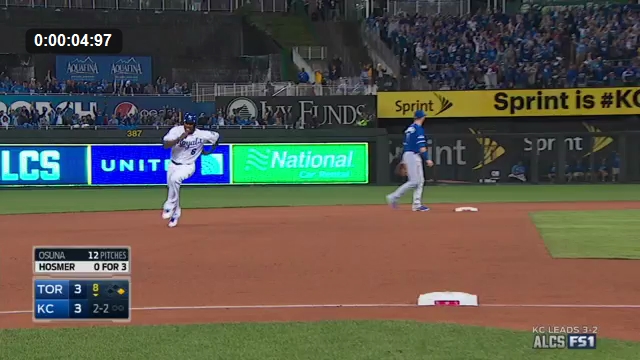
At six seconds, we get out first glimpse at Cain's design. He isn't going to stop at third base. Not without a fight or divine intervention. He's coming in too hot and at too steep an angle for that.

At seven seconds, Cain's foot touches the bag. At 7.5 seconds, third-base coach Mike Jirschele is seen waving Cain on. At eight seconds, the ball finds Troy Tulowitzki's glove around second base. At 8.7 seconds, Tulowitzki is releasing his homeward throw:
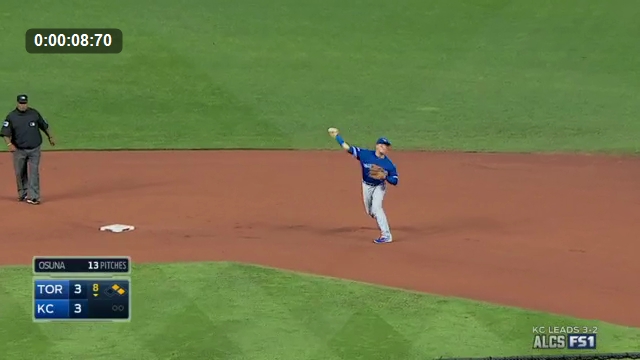
At 9.54 seconds, we see the plate for the first time since Hosmer's contact. It's blurry, and there's no Cain in sight. Just catcher Russell Martin, the baseball, and home-plate umpire Jeff Nelson:
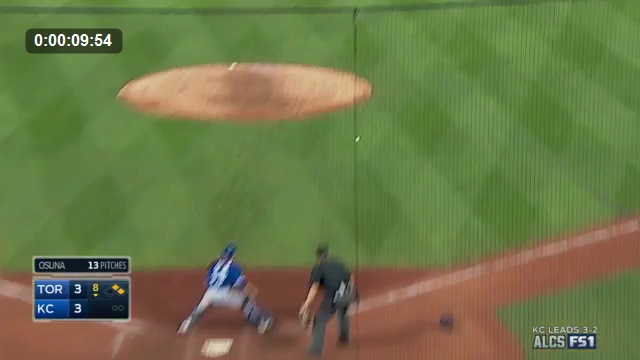
At 9.64 seconds, we see Cain. He's beginning to slide. At 9.84 seconds, stretching begins. Cain to secure the plate, Martin to secure the ball:
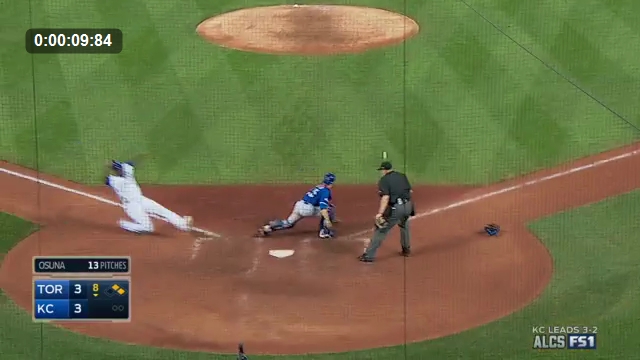
At 10.7 seconds, Martin receives the baseball. And oh, by the way, Cain is safe:
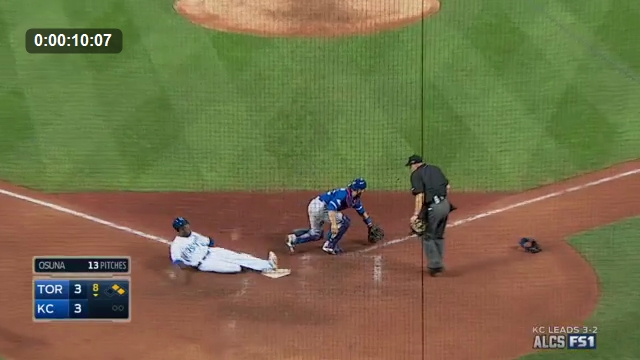
It took Cain less than 11 full seconds to go from his lead at first base to crossing the plate. In fact, it took him less time than that. We later see a shot of Cain at contact. He's not running. He's not even leaning. He's in the process of landing and widening his legs, but from a still shot it looks like he's standing with his hands on his hips, waiting for something to happen:

When something happened, Cain made the kind of play that everyone dreams about in the backyard.
Bautista, on the other hand, made the kind of play that he made all season long. He's probably thrown the ball to second without consequence hundreds of times throughout his career. Heck, we know for certain Cain doesn't make this play all the time. He's been on first when a single has been hit 95 times; he's reached third or scored 38 times, according to Baseball-Reference. That's not even half the time, though that ignores all the meaningful context.
And really, the context is what made this moment meaningful. The Royals were 90 feet from tying the World Series last season. You know how many times Jirschele has heard that? You know how many times he's had to relive that? You know how many times he's woke up from a dream where he waved in Alex Gordon? On Friday night, Jirschele didn't leave anything up to his imagination. Cain did the rest.
***
The game didn't end there. Instead, as if required by the universe to pass on the curse, the Royals handed the Blue Jays their own 90-feet nightmare.
In the interest of brevity, we'll skip ahead to Dioner Navarro's at-bat with runners on the corners and nobody out. All the Blue Jays needed was contact to plate the speedy Dalton Pompey and tie the game. Navarro, inserted for Ryan Goins, seemed like a safe bet to provide it. During the regular season, he put the ball in play 73 percent of the time; he struck out 15 percent of the time. If you had to bet, you'd bet the game would be tied after this at-bat. Nope. Navarro took an outside fastball on 1-1 that was inexplicably called a strike. With this new definition of the strike zone in play, Navarro expanded the plate to chase the same pitch in the same spot. He whiffed. One out:

If Navarro was a safe bet to tie the game, Ben Revere was a sure bet. He has an ugly swing and he couldn't hit the ball out of a sour-cream container, but he's made contact on 91 percent of his career swings. Revere got ahead 2-0, then took a pair of strikes. The first was low but seemingly acceptable, the second was another expansion of the zone. A nasty curve later, Revere was down on strikes as well:

If you're a Blue Jays fan, this is where you start to lose sanity. Nelson had called three out there all night, and two of them changed the complexion of the ninth inning. What if Navarro hadn't had to swing with two strikes? What if Revere were up 3-1? Those calls changed the course of the inning, of the game, of the series, and of the postseason. You don't want to focus on a few strike-zone calls—not in a game like this. You want to put the focus on the players. But the ninth inning challenged that.

Still, the game wasn't over. The Blue Jays had Josh Donaldson, who in a few weeks could be named the AL MVP, step to the plate. He took a fastball for a ball. He then swung through another. A wide fastball later and Donaldson could sit on his pitch. If he walked, Bautista—the Jays' persistent franchise star would step to the plate with the bases loaded.
Donaldson didn't afford Bautista the chance to hit another homer in a dire moment. He yanked a cutter down and moving away to his counterpart, Mike Moustakas, who threw it to first and ended the series.
***
A few seconds here, a couple inches there. The Royals are going back to the World Series.
Thank you for reading
This is a free article. If you enjoyed it, consider subscribing to Baseball Prospectus. Subscriptions support ongoing public baseball research and analysis in an increasingly proprietary environment.
Subscribe now
Hmm. Gibbons must know some rules I don't. :)
The strike zone was a bit uneven all series. Two of the borderline/bad calls the Jays got were in the same at-bat to Eric Hosmer with two on base earlier in the game, and the zone was friendly for Estrada in his excellent start. It did seem the hitters on both teams were having to react to a moving strike zone throughout the series, with a lot of swinging strikes coming soon after missed calls.
That said, the call that went to New York REGARDING THE "SECOND HOMERUN" was clearly incorrect. the fan's glove was clearly over the fence and hanging on to the ball. Ergo, it was a double.
As a fan of a Canadian team, I get the calls...it is all about team revenue from advertising.
All of the Jays earlier games were on in mid-day, because Americans don't give a crap about a Canadian team. They don't tend to care to much about the Royals either, being a small market team...but still better to have KC in than a Canadian team. Same thing is happening with 'our' national game [ignore lacrosse]...most of the players are Canadian, but the American teams will win the games, as it creates more advertising revenue. These aren't sports anymore, they are all about making money...huge salaries for the players, even bigger revenues for the owners. the only people suffering are us poor fans. I think I will take up cross-country skiing and pay more attention to my own life, rather than submitting myself to more advertising.
The strike zone issues are disheartening. The CHI-NY series, although certainly not decided by such issues, had them too. The TBS strike zone box doesn't help matters. It's misleading and distracting. But the strike zone boxes above make it clear the umpire had too large an influence on the game. That's too bad. Not sure what to do about it. Probably has always been true. We just couldn't so clearly prove it. But sad that only half of the recap is about a great play and the other is about officiating. (And I was rooting for KC.)